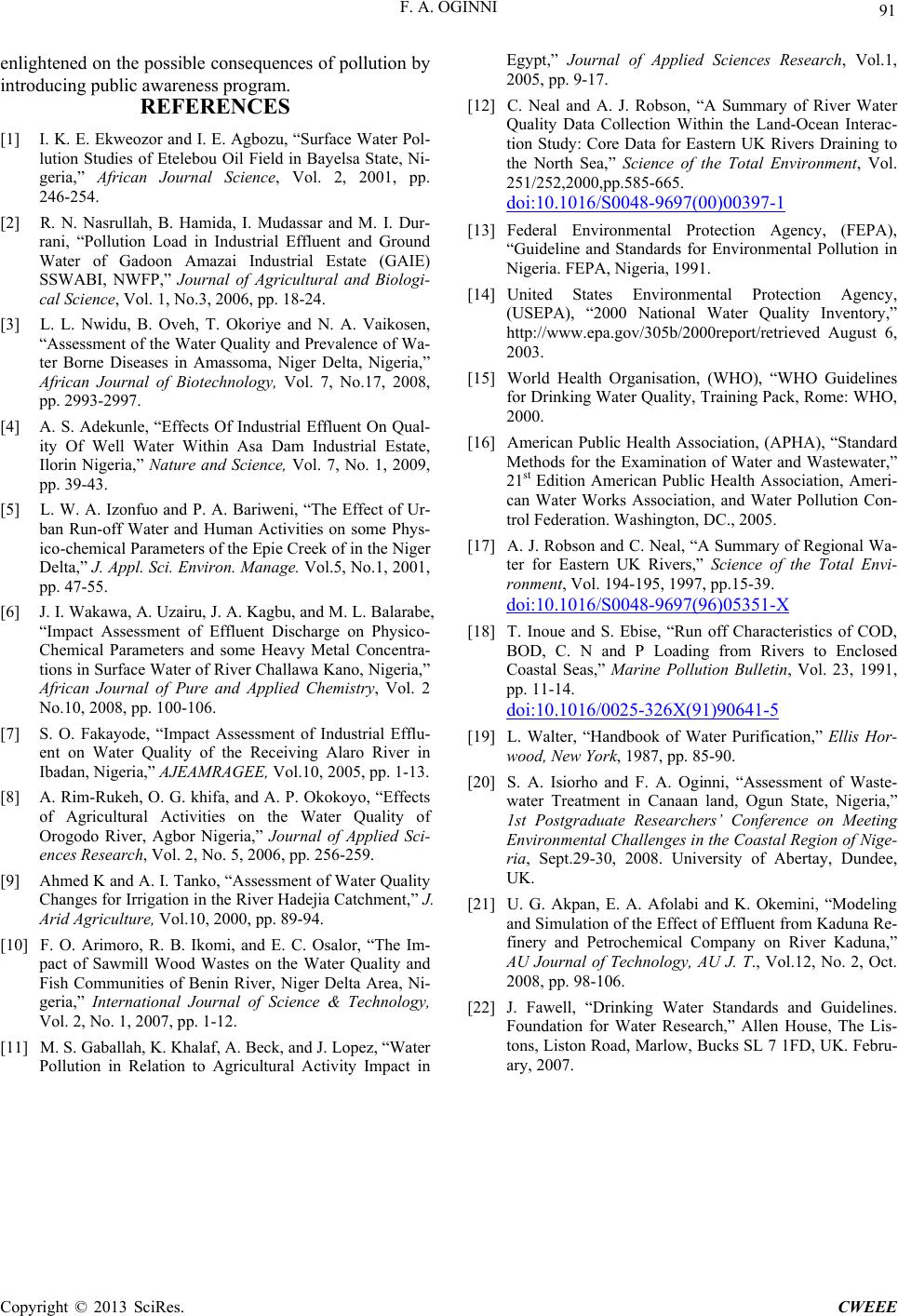
F. A. OGINNI 91
enlightened on the possible consequences of pollution by
introducing public awareness program.
REFERENCES
[1] I. K. E. Ekweozor and I. E. Agbozu, “Surface Water Pol-
lution Studies of Etelebou Oil Field in Bayelsa State, Ni-
geria,” African Journal Science, Vol. 2, 2001, pp.
246-254.
[2] R. N. Nasrullah, B. Hamida, I. Mudassar and M. I. Dur-
rani, “Pollution Load in Industrial Effluent and Ground
Water of Gadoon Amazai Industrial Estate (GAIE)
SSWABI, NWFP,” Journal of Agricultural and Biologi-
cal Science, Vol. 1, No.3, 2006, pp. 18-24.
[3] L. L. Nwidu, B. Oveh, T. Okoriye and N. A. Vaikosen,
“Assessment of the Water Quality and Prevalence of Wa-
ter Borne Diseases in Amassoma, Niger Delta, Nigeria,”
African Journal of Biotechnology, Vol. 7, No.17, 2008,
pp. 2993-2997.
[4] A. S. Adekunle, “Effects Of Industrial Effluent On Qual-
ity Of Well Water Within Asa Dam Industrial Estate,
Ilorin Nigeria,” Nature and Science, Vol. 7, No. 1, 2009,
pp. 39-43.
[5] L. W. A. Izonfuo and P. A. Bariweni, “The Effect of Ur-
ban Run-off Water and Human Activities on some Phys-
ico-chemical Parameters of the Epie Creek of in the Niger
Delta,” J. Appl. Sci. Environ. Manage. Vol.5, No.1, 2001,
pp. 47-55.
[6] J. I. Wakawa, A. Uzairu, J. A. Kagbu, and M. L. Balarabe,
“Impact Assessment of Effluent Discharge on Physico-
Chemical Parameters and some Heavy Metal Concentra-
tions in Surface Water of River Challawa Kano, Nigeria,”
African Journal of Pure and Applied Chemistry, Vol. 2
No.10, 2008, pp. 100-106.
[7] S. O. Fakayode, “Impact Assessment of Industrial Efflu-
ent on Water Quality of the Receiving Alaro River in
Ibadan, Nigeria,” AJEAMRAGEE, Vol.10, 2005, pp. 1-13.
[8] A. Rim-Rukeh, O. G. khifa, and A. P. Okokoyo, “Effects
of Agricultural Activities on the Water Quality of
Orogodo River, Agbor Nigeria,” Journal of Applied Sci-
ences Research, Vol. 2, No. 5, 2006, pp. 256-259.
[9] Ahmed K and A. I. Tanko, “Assessment of Water Quality
Changes for Irrigation in the River Hadejia Catchment,” J.
Arid Agriculture, Vol.10, 2000, pp. 89-94.
[10] F. O. Arimoro, R. B. Ikomi, and E. C. Osalor, “The Im-
pact of Sawmill Wood Wastes on the Water Quality and
Fish Communities of Benin River, Niger Delta Area, Ni-
geria,” International Journal of Science & Technology,
Vol. 2, No. 1, 2007, pp. 1-12.
[11] M. S. Gaballah, K. Khalaf, A. Beck, and J. Lopez, “Water
Pollution in Relation to Agricultural Activity Impact in
Egypt,” Journal of Applied Sciences Research, Vol.1,
2005, pp. 9-17.
[12] C
. Neal and A. J. Robson, “A Summary of River Water
Quality Data Collection Within the Land-Ocean Interac-
tion Study: Core Data for Eastern UK Rivers Draining to
the North Sea,” Science of the Total Environment, Vol.
251/252,2000,pp.585-665.
doi:10.1016 /S0048-9697( 00)00397-1
[13] Federal Environmental Protection Agency, (FEPA),
“Guideline and Standards for Environmental Pollution in
Nigeria. FEPA, Nigeria, 1991.
[14] United States Environmental Protection Agency,
(USEPA), “2000 National Water Quality Inventory,”
http://www.epa.gov/305b/2000report/retrieved August 6,
2003.
[15] World Health Organisation, (WHO), “WHO Guidelines
for Drinking Water Quality, Training Pack, Rome: WHO,
2000.
[16] American Public Health Association, (APHA), “Standard
Methods for the Examination of Water and Wastewater,”
21st Edition American Public Health Association, Ameri-
can Water Works Association, and Water Pollution Con-
trol Federation. Washington, DC., 2005.
[17] A. J. Robson and C. Neal, “A Summary of Regional Wa-
ter for Eastern UK Rivers,” Science of the Total Envi-
ronment, Vol. 194-195, 1997, pp.15-39.
doi:10.1016 /S0048-9697( 96)05351-X
[18] T. Inoue and S. Ebise, “Run off Characteristics of COD,
BOD, C. N and P Loading from Rivers to Enclosed
Coastal Seas,” Marine Pollution Bulletin, Vol. 23, 1991,
pp. 11-14.
doi:10.1016 /0025-326X(9 1)90641-5
[19] L. Walter, “Handbook of Water Purification,” Ellis Hor-
wood, New York, 1987, pp. 85-90.
[20] S. A. Isiorho and F. A. Oginni, “Assessment of Waste-
water Treatment in Canaan land, Ogun State, Nigeria,”
1st Postgraduate Researchers’ Conference on Meeting
Environmental Challenges in the Coastal Region of Nige-
ria, Sept.29-30, 2008. University of Abertay, Dundee,
UK.
[21] U. G. Akpan, E. A. Afolabi and K. Okemini, “Modeling
and Simulation of the Effect of Effluent from Kaduna Re-
finery and Petrochemical Company on River Kaduna,”
AU Journal of Technology, AU J. T., Vol.12, No. 2, Oct.
2008, pp. 98-106.
[22] J. Fawell, “Drinking Water Standards and Guidelines.
Foundation for Water Research,” Allen House, The Lis-
tons, Liston Road, Marlow, Bucks SL 7 1FD, UK. Febru-
ary, 2007.
Copyright © 2013 SciRes. CWEEE